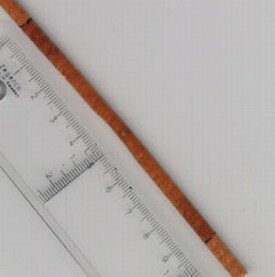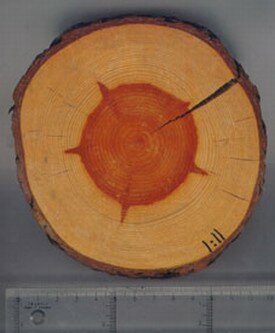
Increment core used for heartwood analyses and for obtaining wood extractives. The heartwood has been stained with sulfanilic acid saturated with sodium nitrite.
The wood of forest trees is a very heterogeneous product. Fiber tracheids of different length and thickness predominate, and these fibers vary in cell wall thickness, spiral grain, microfibril angle and a host of other features. Beside fibers, there are varying proportions of ray cells and resin cells. In addition, stems have a range of different types of wood. Juvenile wood is formed when the trees are young, and later in their life cycles, mature wood is formed. Similarly, earlywood is formed in the first part of each growing season, and latewood in the later part. Furthermore, as the trees age, the central part of the stem is transformed into heartwood. Chemically, the wood also has a variety of different components, among which the most important are cellulose, hemicellulose, lignin and extractives. These substances occur in different forms (chemotypes or isomers) and in different ratios in different types of wood, further increasing its heterogeneity. Despite this variability, the wood is used for many types of products, such as pulp for craft and fine paper, wood for carpentry, timbers for construction and firewood. This is done without separating the different wood types, and the chemical composition is often neglected. To utilize the wood more effectively, the physiological background of its formation need to be better understood. It may in addition be desirable to change specific wood traits in appropriate ways, and if the trait is strongly inherited and the genetic variation is high enough, an efficient way to do this is by genetic breeding.

Stem disc of Scots pine with heartwood in the centre. The heartwood has been stained with sulfanilic acid saturated with sodium nitrite.
Project aims and methodology
Thus, the overall aim of the research we are currently undertaking is to determine the genetic background of key wood traits in Scots pine (Pinus sylvestris L.). The different projects that are included should obtain basic genetic information for the various wood traits, and thus evaluate the possibilities of changing them by breeding. The project is a component of a wider research program at Umeå Plant Science Centre (UPSC) which aims to improve our knowledge of the physiological and genetic background of wood formation processes, and our ability to utilize the wood more effectively.
Thus genetic parameters of the following three major wood characteristics of Scots pine arebeing evaluated:
- the amount of heartwood,
- the content of the most important wood extractives of the heartwood (pinosylvin, fatty acids, resin acids and sterols), and
- the fiber structure, i.e. fiber length, diameter, cell wall thickness and the microfibril angle. These traits will be studied in the sapwood.
The heartwood is of particular interest since it has a high content of wood extractives, which gives the wood resistance against fungi. It is thus well suited for use in outdoor construction, while it is less suited for pulp production. The ratios of the wood extractive isomers, and thus the wood's resistance, may vary markedly. Knowledge of the genetic variation and inheritance of wood extractive contents, and the isomers present, should thus give basic, essential information to help judge the possibilities of improving the product by breeding. Besides within-family differences, variations related to provenance origins may occur. In such cases, transferring seeds or plants according to current recommendations may change wood characteristics in undesirable ways. To study the inheritance and genetic variation of the above mentioned wood traits, we have collected increment cores from two of the oldest and most well-developed plus tree progeny tests of Scots pine in Sweden. Provenance differences were investigated in ten provenance tests in two provenance series in northern and central Sweden.
Current results
So far, heartwood contents have been analyzed, and the genetic parameters of the wood extractives have been evaluated. We have found that the inheritance of the amount of heartwood is high enough to include this parameter in breeding programs. Furthermore are the genetic correlations between extractive contents and growth traits, branch diameter and length of living crown so high that such breeding programs should not reduce saw timber quality. However, no clear differences between provenances, and no transfer effects, have been identified, possibly due to the environmental effects in the studied provenance tests being too large. The inheritance of the content of specific wood extractives show further breeding possibilities, especially for modifying levels of pinosylvin and resin acids.
Fries, A. & Ericsson, T. () Genetic parameters in diallel-crossed Scots pine favor heartwood formation breeding objectives. Can. J. For. Res. 28, 937-941.
Fries, A. () Heartwood and sapwood differences among provenances of mature Scots pine in northern and central Sweden. Silvae Genet. 48, 7-14.
Ericsson, T. & Fries, A. () High heritability for heartwood in north Swedish Scots pine. Theor. Appl. Genet. 98, 732-735.
|